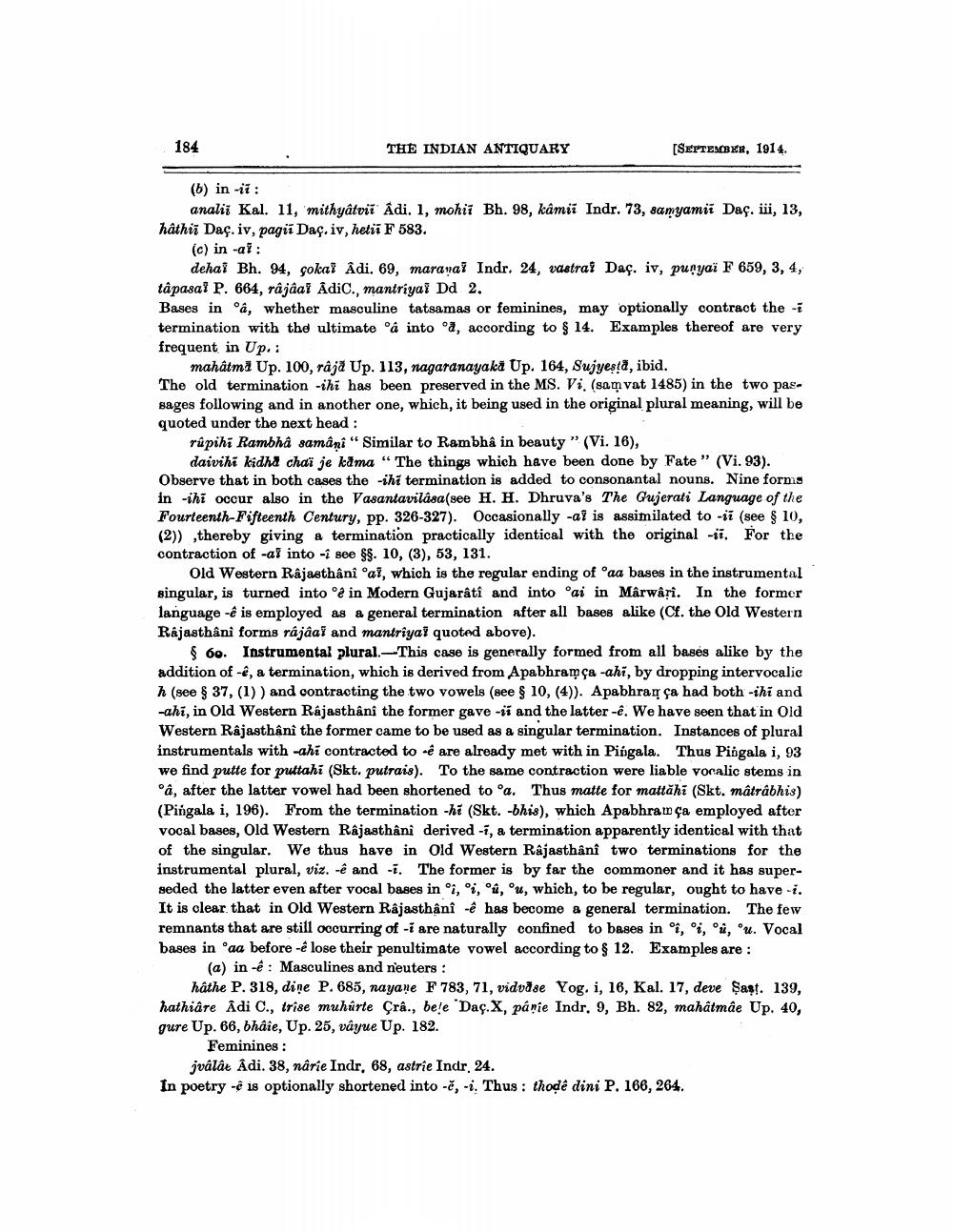________________
184
THE INDIAN ANTIQUARY
[SEPTEMBER, 1914.
(6) in -ii:
analii Kal. 11, mithyâtvii Adi, 1, mohii Bh. 98, kamii Indr. 73, samyamii Daç. iii, 13, hâthis Daç. iv, pagii Daç. iv, heti F 583.
(c) in -al:
dehai Bh. 94. cokat Adi. 69. maranai Indr. 24, vastral Daç. iv, punyai F 659, 3, 4, tâpasal P. 664, râjâai Âdic., mantriyai Dd 2. Bases in a, whether masculine tatsamas or feminines, may optionally contract the -i termination with the ultimate a into "a, according to $ 14. Examples thereof are very frequent in Up.:
mahatma Up. 100, raja Up. 113, nagaranayaka Up. 164, Sujyesta, ibid. The old termination -ihi has been preserved in the MS. Vi. (samvat 1485) in the two passages following and in another one, which, it being used in the original plural meaning, will be quoted under the next head:
rüpihi Rambha samani" Similar to Rambha in beauty” (Vi. 16),
daivihi kidha chai je kama "The things which have been done by Fate" (Vi. 93). Observe that in both cases the ihi termination is added to consonantal nouns. Nine forms in -ihi occur also in the Vasantavilasa(see H. H. Dhruva's The Gujerati Language of the Fourteenth-Fifteenth Century, pp. 326-327). Occasionally -al is assimilated to -ji (see $ 10, (2)) thereby giving a termination practically identical with the original -7. For the contraction of -al into -i see $. 10, (3), 53, 131.
Old Western Rajasthani Rai, which is the regular ending of 'aa bases in the instrumental singular, is turned into a in Modern Gujarati and into ai in Mârwâți. In the former language -ê is employed as a general termination after all bases alike (Cf. the Old Western Rajasthani forms räjäai and mantriyal quoted above).
$ 60. Instrumental plural. This case is generally formed from all bases alike by the addition of -é, a termination, which is derived from Apabhramça -ahi, by dropping intervocalic h (see $ 37, (1)) and contracting the two vowels (see $ 10, (4)). Apabhrar ça had both -ihi and -ahi, in Old Western Rajasthani the former gave - vi and the latter -ê. We have seen that in Old Western Rajasthani the former came to be used as a singular termination. Instances of plural instrumentals with -ahi contracted to é are already met with in Pingala. Thus Pingala i, 93 we find putte for puttahi (Skt. putrais). To the same contraction were liable vocalic stems in
à, after the latter vowel had been shortened to "a. Thus matte for mattăhi (Skt. mâtrâbhis) (Pingala i, 196). From the termination -hi (Skt. -bhis), which Apabhram ça employed after vocal bases, Old Western Rajasthani derived -i, a termination apparently identical with that of the singular. We thus have in Old Western Rajasthânî two terminations for the instrumental plural, viz. -e and -1. The former is by far the commoner and it has superseded the latter even after vocal bases in oi, oi, o, ou, which, to be regular, ought to have -i. It is clear that in Old Western Rajasthânî ê has become a general termination. The few remnants that are still occurring of -i are naturally confined to bases in oi, oi, ou, ou. Vocal bases in aa before -e lose their penultimate vowel according to $ 12. Examples are :
(a) in -e: Masculines and neuters :
hâthe P. 318, dişe P. 685, nayane F 783, 71, vidvase Yog. i, 16, Kal. 17, deve Şast. 139, hathiâre Adi C., Irise muhůrte Crâ., bele Daç. X, pánie Indr, 9, Bh. 82, mahatmâe Up. 40, gure Up. 66, bhaie, Up. 25, váyue Up. 182.
Feminines :
jválát Âdi. 38, narie Indr, 68, astrie Indr. 24. In poetry -e is optionally shortened into -ě, -. Thus: thode dini P. 166, 264.




